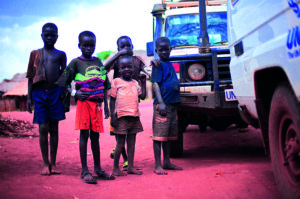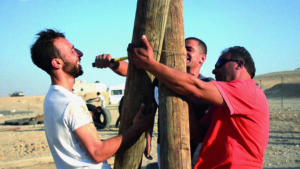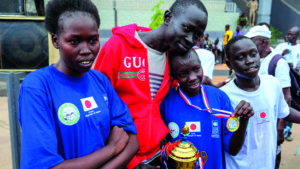Working in the field of peace and conflict resolution involves a particular set of demands. Funders need to be aware and willing to meet them
Lebanon, Syria, Rwanda, Colombia, Sri Lanka, Ukraine, Vietnam, Kashmir – this is only a short list of the more recent conflicts that have dogged our collective history, yet, as many contributors to this special feature point out, peace-related grantmaking, at less than one per cent of all grantmaking, seems irresponsibly small.[1]
The need to find successful interventions to solve this complex issue is urgent. So, too, is the need to reconceptualise what we mean by peace philanthropy. If our goal is durable peace, the solutions and funding cannot be purely security oriented.
Peaceful, stable societies are needed for communities to thrive. From the other side, inclusive and equitable societies with access to education, healthcare and freedom of expression are absolutely key for sustainable peace. As funders, we need to support grantee efforts to ensure diverse perspectives are not just heard but truly represented in proposed solutions, and in grantee organisations themselves.
Where philanthropy is not…
Philanthropy is less involved in peace-building than in any other programmatic area in which it works. South Sudan is just one country that is not explicitly discussed in this special feature, yet constantly makes the headlines. Over 13 years, only $7.5 million has gone directly to local recipient organisations. Of this, a mere half million dollars comes from funders who actually describe their work as contributing to peace-building efforts – Virginia Gildersleeve International Fund, National Endowment for Democracy, Mensen met een Missie and Global Fund for Women Inc. By contrast, funders have provided $13.2 million to peace-building and
$97.8 million overall in support of South Sudan to either intermediaries or for research and work related to South Sudan.
The presence of a peacekeeping mission may deter philanthropy, suggesting a country that is too unstable for the sector to work in, but it also creates a direct opening for philanthropy, and a policy platform to coalesce around.
It’s important to note, however, that the picture is more nuanced, and intermediaries come in different shapes and sizes. Intermediaries here include large multilateral aid organisations, big INGOs, and US-based public charities that specialise in channelling funds directly to grassroots organisations in the Global South. Local intermediaries also play a crucial role.
This highlights two key questions. The first is why are funders resistant to grantmaking related to conflicts where their funding could be uniquely helpful in supporting transition from violence to cooperation? The second is how do we get more funders to see that their work is vital to peace-building and creating durable peace?
Accessing hard-to-reach places through pooling and partnering
Countries going through a peace-building process need policy solutions and catalytic funding, and philanthropy can be a partner in both. South Sudan has a United Nations Peacebuilding Fund, support from many UN agencies including UNDP, and a Peacekeeping Mission. The presence of a peacekeeping mission may deter philanthropy, suggesting a country that is too unstable for the sector to work in, but it also creates a direct opening for philanthropy, and a policy platform to coalesce around.
If the question of when to enter really is the challenge, the notion that post-conflict peace-building can be divided into three dimensions – stabilising the post-conflict zone, restoring state institutions and dealing with social and economic issues – is one characterisation of this which may be helpful in finding an intervention point.
Foundations have a role to play at the earliest stage of the post-conflict and peace-building process, acting as convenors and helping to mobilise funds for local NGOs and community philanthropy. Opportunities to pool funds and set up blended finance mechanisms can enable foundations to reach these first responders in harder-to-access places and situations. There are already several global pooled multilateral funds to which philanthropy (Waterloo Foundation, UK, Al Jisr Foundation, Oman, and CMAX Foundation, USA) has contributed, such as the Central Emergency Response Fund (CERF). In addition, peace-building funds such as that of the aforementioned Peacebuilding Fund in South Sudan could be further leveraged by philanthropy.
The Sustainable Development Goals (SDGs) also have the potential to act as a north star for philanthropy, the UN and the broader ecosystem to work together related to peace-building. SDG 16 aims to ‘promote peaceful and inclusive societies for sustainable development, provide access to justice for all and build effective, accountable and inclusive institutions at all levels’. The SDG Philanthropy Platform is a mechanism for bringing philanthropy together around the SDG policy table that has also been covered in this issue.
Barriers to funding
Are there other barriers to funding? Are funders unable to get grants across borders? Are they having trouble finding these local organisations or local intermediaries? Are we as funders asking too much of grantees in the name of due diligence – forcing potential grantees into the conventions and boxes we are comfortable with, rather than seeing what is truly needed?
The much-discussed shrinking space for civil society has made itself particularly felt in peace-related philanthropy, both by grantees and funders. Indiana University’s Global Philanthropy Environment Index shows that the environment for philanthropy is restricted in 40 per cent of the 79 countries and economies that it studies.
Beyond government restrictions, civil society is increasingly subject to banking regulations introduced as counter-terrorism measures; research done by the Charity and Security Network found that two-thirds of US non-profits working abroad are having difficulties sending funds internationally – from wire transfer delays to account closures. It’s incumbent on us as funders to advocate for responsible regulations and be understanding of the challenges that grantees are encountering in their operations. It is not enough for us to ask how they are doing in just the substantive work, we also need to be a source of support for their overall operations. Are there alternative ways of getting funds to grantees, particularly those working in conflict and post-conflict situations?
Engaging people and communities directly
So often, approaches to peace focus on military and security interventions, and do not engage the people who are directly affected by conflict in creating the solution. They do not take into account, for instance, food sovereignty for the local population, or fair access to water, or strengthening local economies. These aspects are crucial in ensuring stability with targeted populations. In fact, some of the programmes designed for peace-building unintentionally reinforce the power gap between those involved in conflict, forcing those with less power and resources to ‘normalise’ relationships with the more powerful, which serves neither peace, nor justice.
Considering the range of issues that grantees face, peace philanthropy funders should opt for flexible funding whenever possible, and also leverage their roles to think about what support beyond the grant would be helpful for grantees.
Given its crucial local knowledge and understanding, community philanthropy is part of the ecosystem that needs to be continually supported and nourished. The growth of community foundations around the world attests to increasing awareness that solidarity at the grassroots level ensures sustainability of the local resources and that community foundations, in the Global South particularly, tend to use participatory grantmaking. In other words, decisions are made by and with the community itself. This means that there is a sense of ownership in the decisions made by the communities. There is more determination to ensure that the decision is carried out and benefits are distributed among all members of the community involved. Could all types of foundations/philanthropy provide more funding to community philanthropy to carry out peace-building work?
In this special feature, contributions from community foundations highlight the importance of social movements and solidarity in creating the conditions for lasting peace.
Responsive grantmaking
As funders, it is important to have strategies through which we approach our funding, but it is essential to remember throughout that these may need to be adapted to developments on the ground and the needs of grantees. This is especially true of those who are working in conflict and post-conflict situations. We need to trust our grantees and let their experiences inform our work as funders.
As well as exercising stewardship of the funds we disburse, we also need to ensure that we are able to steward relationships with grantees in a way that allows for the ups and downs they may encounter. Processes should be kept nimble and grant requirements streamlined. This allows all parties more time to focus on the substantive work at hand and cultivates a deeper sense of trust in the relationship.
Considering the range of issues that grantees face, peace philanthropy funders should opt for flexible funding whenever possible, and also leverage their roles to think about what support beyond the grant would be helpful for grantees.
Constellations of grants
Funders working in this space need to understand that to get to durable peace, we need to engage not just the communities directly affected by the conflict, but also government and other actors more explicitly engaged in it. The solutions will not come from one grant, but rather constellations of grants that are responsive to local context. When trying to understand impact, therefore, it is important for funders to take a long view, while acknowledging the contributions that the work of grantees and others make along the way.
The support ecosystem
Ideally, funders should also be partners for organisations doing frontline work, leveraging their networks and contacts to create connections and build helpful relationships that can yield more than financial benefits. Philanthropy can mobilise capital and resources including human expertise. Community philanthropy understands its people and what they really need and want. The multilateral system understands how to co-create policy. This makes for the underpinnings of an ecosystem which, if it functions effectively and in trust-based relationships, could perhaps create a basis for philanthropy to truly partner on peace-building efforts.
Lauren Bradford is senior director of Global Projects and Partnerships, Candid.
Email: [email protected]
Twitter: @laurenjbradford
Hope Lyons is director of Program Management, Rockefeller Brothers Fund.
Email: [email protected]
Twitter: @hopelyons
Rasha Sansur is communication and resource mobilisation officer of the Dalia Association-Palestine.
Email: [email protected]
Twitter: @SansurRasha
The post In search of peaceful development appeared first on Alliance magazine.
Source: Alliance magazine



